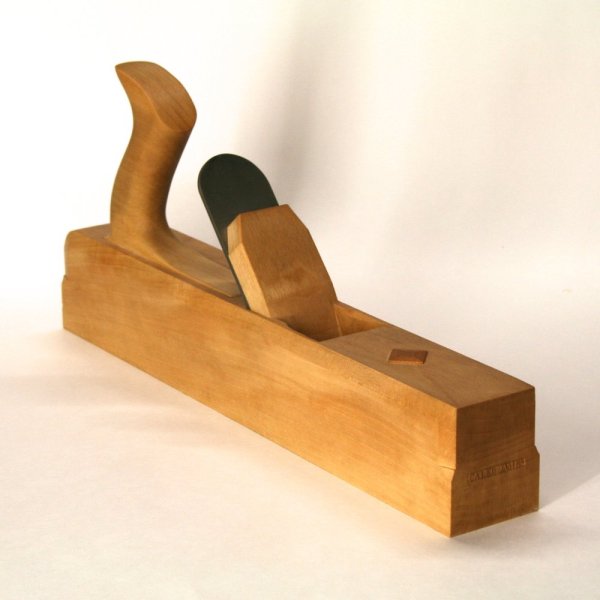
After a small flurry of emails this past weekend related to the dust jacket in which Nancy, Christopher, Megan and I discussed word choice, the number of lines, the space between “Shop” and “Tails” and more, “Shop Tails” is now at the printer.
Makers, whether of a dust jacket, a book, a spoon or a kitchen, tend to eschew materialism, or, at least certain types of materialism. And yet we make material goods. As Nancy writes below, the “things vs people” dichotomy can be false and destructive, and that holds true whether you’re talking about a person on a factory production line or someone working in a one-person workshop.
In this excerpt from Chapter 11, Winnie (1996-2010), Nancy addresses the concept of materialism, and suggests considering a new way of looking at objects – appreciating how things embody important characteristics of their makers, as well as memorialize others.
— Kara Gebhart Uhl
When Winnie, William, Lizzie, Tom and I officially moved into the house next to my shop in the winter of 2004-2005, I kept the dogs confined to the laundry room and kitchen instead of giving them free run of the house. Not only was I loath to see any repeat of the destruction at my bungalow in town; I had begun laying the hickory floors in my spare time, and it was an unimaginably slow job, done on my hands and knees.
Alan had kindly loaned me a flooring nailer. It was the manual type you whack with a dead-blow mallet. I tried it repeatedly, but the hickory was so hard it just bent the nails. Once a nail was bent, it was far more time-consuming to remove from the dense wood than it would have been to drive by hand. A pneumatic nailer might have done the trick, but I didn’t have one, so I bought several pounds of large finish nails and recalibrated my expectations. I had to pre-drill the tongue of each board about every 18 inches along its length to keep it from splitting. I drove the nails with a hammer and finished with a nail set. It took a week of spare time to lay the floor in the 13 x 18-foot living room, but as I watched the hickory spread slowly across the OSB subfloor, I was thrilled by the transformation in my surroundings.
After the living room I moved down the hall to the bedrooms, then hired my friend John Hewett to sand the floors. I applied two coats of Waterlox Original tung oil just before driving to Florida with a kitchen full of cabinets for Maggie and her husband – the tung oil was so heavy on the solvent that I didn’t want to be in the house while it cured.
Considering how much work the floors took, I was not about to see them scratched up by the dogs’ claws, so I decided to confine them to the kitchen and laundry room, rather than allowing them the run of the house.
***
Every so often someone complains that I’m too protective of material artifacts, whether the floors in my house, the top of our kitchen table or the quilt made by our friend Kim, a gift when Mark and I were married – “Use the delicate cycle! Those are Kim’s hand-sewn stitches!” These criticisms, which are often veiled, pit things against people (or things against dogs, in the case of my floors), implying that I value the former over the latter.
I get it. When I was around 10, Esse, gave me a melodica, a hybrid between a wind instrument and a keyboard. You blew into a mouthpiece, pressing keys to produce different notes. The resulting sound struck me as artificial, and the instrument itself was mostly made of plastic. It didn’t seem like a serious instrument. I had no idea back then that the melodica was good enough for the coolest of professional musicians, like Jon Batiste on “The Late Show with Stephen Colbert.” I was touched that she’d bought it for me, but not that interested in learning to play it.
The gift of the melodica coincided with the influx of hippies living in our yard. From them I learned that attachment to material things was bad. “You gotta let it go, man. Free yourself,” they’d say – not about my melodica, but about other, grown-up things. Their happiness living with few possessions impressed me. I wanted to follow their example. So one Saturday morning, when a couple mentioned they were going to a swap meet to divest themselves of still more possessions, I asked if I could join them. It would be an exercise in renunciation.
I set the melodica down with a bunch of other people’s stuff on a fold-up table in a dusty parking lot cooked by the Florida sun. I think I priced it at $25. Eventually someone haggled me down to $8. The money wasn’t important; what mattered was that I was letting go of another object I didn’t use. I was training myself to avoid attachments. I overrode the pang of guilt as I took the cash – my dear grandma had given the instrument to me – and told myself to grow up. When I told my grandma, she was hurt. “I bought that for you,” she said. “It was a gift.” She wasn’t trying to make me feel bad; she was expressing how she felt. I’ve been troubled by my superficial take on the melodica ever since.
As I thought about that experience over subsequent years, I came to see “things versus people” as a dichotomy that’s false and destructive. You can’t even have things without people; we’re interdependent. People make things, whether they do so on a factory production line or in a one-person workshop. Then other people put them to use. Beyond this, things are more than mute material; they express their makers’ dreams and values. This connection between maker and made object is most visible in artifacts crafted by individual makers to their own designs, or designs they’ve adapted significantly – think Megan Fitzpatrick’s Dutch toolchests, or Danielle Rose Byrd’s bowls. But even anonymous workers on the production line at Toyota or General Electric are expressing their dreams of a good life, albeit less directly, as they cut, weld or assemble parts to other peoples’ designs using tools and equipment they don’t own.
Material artifacts are also repositories of memory. They keep people and places alive. In my office I have a Victorian bamboo étagère, its shelves filled with antique ceramics. The stand and all of its contents – a Dutch urn resembling an antique from Greece; two sugar-and-cream sets from Japan; pitchers and vases from Germany, Romania, England – once stood in the entryway of my friend Peggy’s house, a converted timber-frame barn. She’d bought the barn in pieces and made it into a home filled with character and natural light. I always coveted the pottery collection (and kicked myself for doing so, because it was hers). After Peggy died, her daughter held a barn sale. I bought the shelf and the ceramics – not only because I loved them, but to keep those things together as the Peggy Shepherd Pottery Collection. Peggy lives on in these artifacts, as well as many others in our home: the curvy black metal chair she gave me at Christmas in 1998, the funky painted cabinet a former boyfriend of hers had cobbled together, the beautifully upholstered chair she gave me after I built cabinets for her barn-house kitchen. “You didn’t charge me enough,” she said. “I want you to have this.”
The World War II-era sofa in our living room, which I bought from Peggy many years ago, reminds me to be thankful that we’re not hiding in bomb shelters while subsisting on tinned meat, chicory “coffee” and other rations. The salvaged leaded-glass window I built into our bathroom wall carries forward the legacy of a client’s family home that was demolished as part of an airport expansion. The ceramic model of a terraced house on my office bookshelves reminds me of my first woodworking boss, Raymond, who gave it to me when Patrick and I were married, adding “You’ve always said you want a house of your own.”
When we buy things from those who make them, we not only support those craftspeople, we also do our part to keep craft traditions alive. In the factory-made Arts & Crafts-style cabinet I bought tenth-hand from a back room in a Bloomington grocery store in 1995 lies a silver cheese knife made by Hart Silversmiths in Chipping Campden, England, the lone surviving enterprise from Charles Robert Ashbee’s Guild and School of Handicraft. Mixed in with blue-green ceramics bought at yard sales and junk shops is a vase bought for me by my former husband, Kent, and his wife, Mary, on a visit to the Van Briggle Pottery & Tile. There are small pieces by Ephraim Faience that I purchased at The Omni Grove Park Inn and a Granny Smith green cabinet vase I bought from Scott Draves of Door Pottery in 2015, when we were in neighboring booths at a show in Chicago.
Even mass-produced artifacts deserve more respect than we generally give them, at least in the States. We have a famously materialistic culture in which too few people have more than the most superficial, consumerist understanding of material objects. As Elaine Scarry pointed out in her 1985 book, “The Body in Pain,”
…anonymous, mass-produced objects contain a collective and equally extraordinary message: Whoever you are, and whether or not I personally like or even know you, in at least this one small way, be well…. Whether they reach someone in the extreme conditions of imprisonment or in the benign and ordinary conditions of everyday life, the handkerchief, blanket, and bucket of white paint contain within them the wish for well-being: ‘Don’t cry; be warm; watch now, in a few minutes even these constricting walls will look more spacious.’1
Instead of “things versus people,” it would be more fitting to appreciate how things embody important characteristics of their makers, as well as memorialize others.
The things we live with also shape us in ways we often don’t even see. They impose their own demands on our behavior: We have to learn how to use the new email platform, drain the compressor, grease the sander’s gears, prime the pump. Many things, from the humble kitchen whisk to the thickness planer, bicycle or car, become extensions of our bodies, magnifying our abilities, for better or worse, and sometimes leading us to imagine ourselves more powerful than we are. (All it takes to prove the validity of this statement is a power outage.)
1Scarry, “The Body in Pain” 292.
— Nancy Hiller, author of “Kitchen Think” and “Making Things Work.” Read Nancy Hiller’s profiles, which we call “Little Acorns,” via this link.















